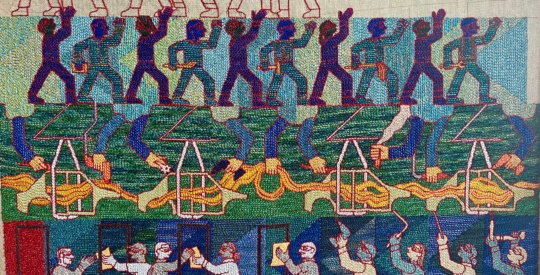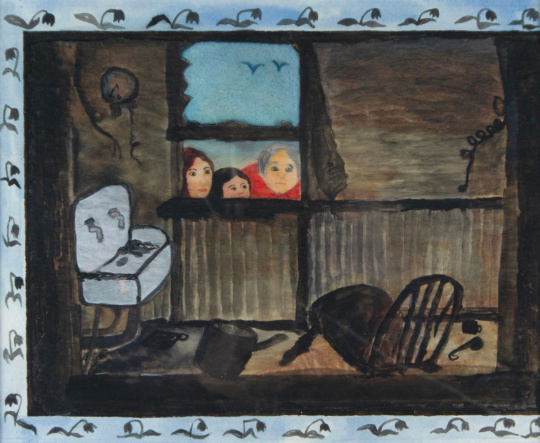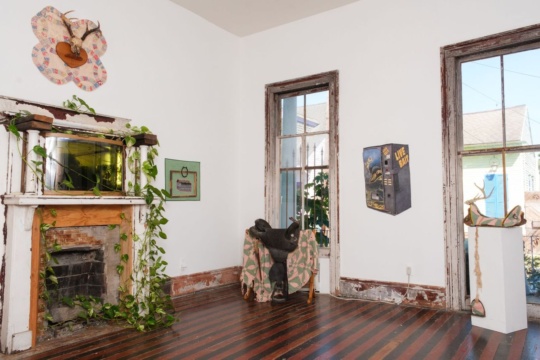
I am about to write about Arturo Lindsay’s Portraits of Yemaya, which is at City Gallery at Chastain until March 22. But first I need to explain a couple of things that have a direct impact on how the show should be understood. They have to do with the (biologically given) perception of pattern and the (culturally imposed or modified) discovery of meaning.
Visual art in all its forms (from design to the decorative arts all the way to conceptual art) is the result of a combination of the capacity to perceive patterns in the world and the will to find meaning in those patterns. That inborn capacity and that will-to-meaning are both further developed through education, starting with our parents’ instruction in infancy and coming at us thereafter in ways that can range from graduate seminars to the school of hard knocks. The kind of art we like, or the kind of art we make, depends on how our perceptions of patterns are developed by the meanings we are given and that we modify.
A few random examples of the diverse results of this dual process would include the Atlanta brand of hip-hop recently written up in the New York Times, the abstruse and difficult objects and installations found in global biennials, and the shifting forms of fashion presented in a host of different media—media including the style sections of the aforementioned New York Times, which deliver pattern and meaning to a specific subgroup of visual consumers just as Artforum delivers the patterns and meanings of the biennials to a different or overlapping subgroup.
Such things as conceptual photography are at one end of this extended spectrum, and such things as running shoes are at the other. In between come all the other possible combinations of pattern and meaning. In some of them, pattern is predominant and meaning is secondary; in others, meaning is dominant and pattern is so minimal as to provoke the familiar reaction, “That’s not art!” People at one extreme of the pattern-and-meaning continuum usually view people at the other end of it with contempt.
It may seem strange to provide such a theory-laden preface to a review of what might all too easily be viewed as a show of travel photos by Arturo Lindsay at Chastain. What the visitor sees upon entering is a wall drawing of repeated images of ships, a sea-themed sculptural installation of paper boats and conch shells, and a series of color photographs of fishermen, boats, windy coastlines, and sunrises and sunsets over the ocean. These are well-composed images, effectively arranged on the wall with regard to themes and subthemes, but at first glance they seem to fall into very familiar photographic genres, and some viewers might well see no more in them than that.

Hence an introduction like the one I have given is essential to understanding a body of work that is nothing less than an attempt to compose a visual treatise (Lindsay’s own description of the project). The treatise (which is, as Lindsay observed in his artist’s talk, something more deep-reaching than an essay) is about the characteristics of Yemaya, the Santería orisha or divinity associated with the ocean—a spirit who might be described as the ocean mother, or the mother who on one level is an autonomous force and on another is the sea itself. For Yemaya has many faces, and many meanings. We find her meanings, Lindsay proposes, by looking for her patterns in the world, as Santería practitioners see it with eyes made properly alert.
Santería is one of the African Diaspora‘s creative outcomes of the religion of spirits and forces that is practiced by the Yoruba peoples of West Africa. As developed under different conditions of slavery and liberation in the Americas, this spiritual expression has embodied a complex visual and conceptual aesthetic in its altars and its devotional and ritual practices. Lindsay has written extensively on the subject of Santería aesthetics in contemporary art, and he conducts ongoing research into Santería practice in sites ranging from coastal sites in his native Panama, to places of Santería worship and celebration in New York City, where he grew up and was educated. Equally, he has created his own art paying homage to the orishas and the traditions surrounding them. His art and his scholarship mutually inform each other.

Thus we might arrive at the gallery expecting photographs of, say, devotions to Yemaya in which candles or floral homages are set adrift on the ocean waters. What we see instead is what Lindsay wishes us to perceive as the manifestations of Yemaya.
It isn’t that the net-casting fishermen or the wooden fishing boats (one of which bears a painted Egyptian flag) reflect the worship of Yemaya; it’s that these phenomena, plus the interaction of light and water at sunrise and sunset, can, when rightly viewed, tell us something about who is Yemaya. Once one has the eyes through which Yemaya can be seen, the patterns and meanings through which Yemaya becomes visible, one can find Yemaya equally well in Egypt, where Lindsay encouraged the Cairo children who were his students to create paper “boats of dreams” to represent the ideal city in which they wished to live.
Like Yemaya, these dreams are invisible, and they require the acquisition of certain prior information and a certain way of seeing in order to understand what is happening. Dreaming of the future is cross-cultural and universal—like motherhood, and like the ocean, which, despite its artificial divisions into differently named seas, is a single body of water that embraces the entire planet.
Yemaya, however, is a very specific divine lens through which to see the sea and the shared archetype of the mother that comes to us individually through such different social and cultural conditions. Lindsay finds Yemaya’s face in his specific encounters with the ocean’s beauty and with the livelihood that it provides to humans (or provides when pollution hasn’t profaned the realm in which Yemaya lives and moves and has her being).

Other viewers, bringing their own sets of patterns and meanings to these photographs, will inevitably find something else in them. As with any other form of art, whether they find satisfaction will depend on their own expectations and emotional associations.
It might help viewers to see these photographs for what they are if they were informed more explicitly of Lindsay’s conceptual and aesthetic agenda. We see what we have been prepared to see. And when we have been thus prepared, we see differently—even if we retain our own rules for what makes a meaningful pattern and what doesn’t.




